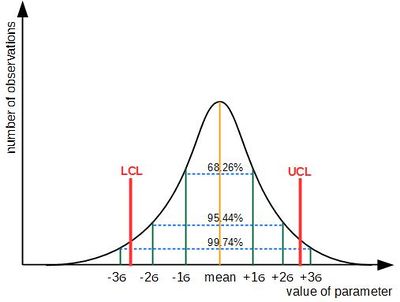Six sigma: Difference between revisions
(Infobox update) |
(The LinkTitles extension automatically added links to existing pages (<a target="_blank" rel="noreferrer noopener" class="external free" href="https://github.com/bovender/LinkTitles">https://github.com/bovender/LinkTitles</a>).) |
||
| Line 45: | Line 45: | ||
==Methods== | ==Methods== | ||
The Six sigma program uses many well known methods, e.g. [[Quality Function Deployment]], [[Quality loss function]], [[Fish diagram]], [[Root cause analysis]], 5 whys. | The Six sigma program uses many well known methods, e.g. [[Quality Function Deployment]], [[Quality loss function]], [[Fish diagram]], [[Root cause analysis]], [[5 whys]]. | ||
==Statistics behind Six sigma== | ==Statistics behind Six sigma== | ||
Revision as of 01:50, 21 January 2023
| Six sigma |
|---|
| See also |
Six sigma () is a method of production system improvement performed in order to achieve a product of perfect quality. The method base on statistical process control and other statistical tools to find causes of problems. The team of employees works on causes to remove it. The method was developed by Motorola in USA in 80s and popularized after the company achieved Malcolm Baldridge National Quality Award.
The name of the method refers to statistical tools. The 6 sigma is the level on which only 3,4 defects occurs per 1 million of operations (not products! each product requires many operations). That means 99.9997% error free operations.
Nowadays Six sigma is often linked with lean approach as Lean-six sigma.
Application of Six sigma
The statistics behind six sigma is really simple (see below). The heart of the program is organizational change. It is relatively easy to improve quality to 2-3 sigma buying new equipment. But each next level becomes harder to achieve. In literature the level of 4.7 sigma is known as critical. Moving beyond this requires usually rethinking of all the process. Organizations don't have to reach 6 sigma with each operation. They usually go so far with the most important ones.
DMAIC improvement cycle
DMAIC is modified PDCA cycle, which includes:
- Define the goals
- Measure characteristics that are critical to quality
- Analyse the process and product and develop alternatives
- Improve the product and process
- Control the future state of the process (to avoid entropy)
Some authors propose modified names of the cycle.
Black belts, green belts
Black belts and green belts are managers or employees that have certain roles in the program. The main roles are:
- Leaders - the CEO and top management
- Champions - upper management, mentors of black belts
- Master black belts - in-house coaches
- Black belts - operate under masters in specific projects
- Green belts - employees who work with six sigma implementation
The system of roles shows that program is being implemented with extensive participation of higher management. This is the opposite approach to Japanese ideas like Total Quality Management or Lean management. It's one of the weaknesses of Six sigma.
Methods
The Six sigma program uses many well known methods, e.g. Quality Function Deployment, Quality loss function, Fish diagram, Root cause analysis, 5 whys.
Statistics behind Six sigma
To understand what's behind Six sigma we need several terms:
- normal distribution (the Gauss curve)
- Variability of parameters is typical for every process. After many repeats of the process, we can collect enough data to draw a histogram showing what values monitored parameters have. Let's assume, you cut slices of bread. Each will have a bit different thickness. If you measure the thickness and draw a histogram you'll probably end with a bell curve. The most of slices will have thickness about the mean, and the further from the mean the smaller the number of slices.
- standard deviation ()
- It's a measure of variability. You can compute it analysing difference between mean thickness and thickness of each slice of bread. The standard deviation is interesting, because:
- between mean - and mean + there should be 68.26% of all data.
- If you increase this scope to mean plus/minus it will be 95.44%.
- In case of mean plus/minus it will be 99,74%.
- In case of mean plus/minus it will be as you already know 99.9997%
- The control chart was invented by Walter A. Shewhart. It shows the variability of the process on simple chart. It defines two limits: lower control line and upper control line. It the parameters of the product are within those lines - the product is good, otherwise it's a defect.
We want all the products to be within control lines. The idea of Six sigma is to make the process very stable. This allows to reduce the standard deviation. It should be so small, that 6 standard deviations from the mean should fit between mean and each control line. In that case our we'll achieve 99.9997% correct operations.
Criticism
Modern research results show that 6 sigma programs only in much less than 50% of companies end with profits. The success of Motorola was not repeated by over half of enterprises that tried to do it.
References
- The Six Sigma Handbook
- Kwak YH, Anban FT (2006) Benefits, obstacles, and future of six sigma approach, Technovation, 25:5-6
- Linderman K, Schroeder RG, Zaherer S, Choo AS (2003) Six Sigma: a goal-theoretic perspective, Journal of Operations Management, 21:2
Author: Slawomir Wawak






